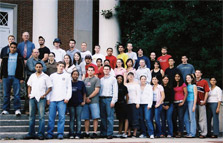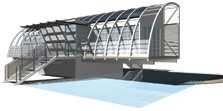

Overcoming challenges brought Maryland's team closer together.

Maryland's fluid design "floats" above the ground.
Solar Decathlon 2005
University of Maryland
Teamwork Rises to the Occasion
Learning how to make the most of diverse interests and talents. Delving into cross-disciplinary issues that they'll face in the workplace. Finding ways to keep people motivated on a demanding project spanning more than two years ... these are but a few of the challenges that the University of Maryland students are proud of conquering. Richard Magnani, the team's structural consultant, comments, "I've been particularly impressed with the resourcefulness of these young people. They started out with a project they had no idea how to do, and they're finding the resources, manpower, and money to make it happen."
This team emphasized student leadership, developing and ratifying a team constitution early on. Next, in a design competition and studio, they evaluated a number of draft designs. Maryland student Najahyia Chinchilla sums up their design approach: "To us, sustainability is not a product to be added onto a house, but a way of living."
Student Luming Li, the architect of the design they chose, originally envisioned a house "floating" over a field of water, describing it as "anchored to the earth, yet touching it lightly." To marry that vision with the practicality of transporting the house to the National Mall, the students chose to rest the house on a field of stone. Their iterative design process led to a final design with "very clean and simple" lines.
The home's PV system—comprising 51 charcoal-gray BP Solar panels—adds to its aesthetic appeal. Student Tom Serra says, "We made a statement by integrating the panels into the home's design, not hiding them." The roof also incorporates curved roof joists, furthering the "fluidity" of the home's exterior.
Inside, a radiant heating system warms the concrete floors, which also generate passive heat by absorbing the sunlight streaming through the home's large windows. To make the interior spaces comfortable, the team is using an energy recovery ventilator combined with a small central cooling unit. Serra points out another challenge: "finding a cooling unit that was small enough; most air-conditioning units are sized for larger homes."
And in keeping with their determination to meet all challenges, six team members had to get creative when they arrived in Orlando for the January 2005 International Builder's Show. Finding that a reservations mix-up had left only one hotel room available, these students simply made it work—by "managing" their stay as just another team project.
Team Contact
Dr. Kaye L. Brubaker
Civil & Environmental Engineering
Glenn L. Martin Hall
College Park, MD 20742
301-405-1965
